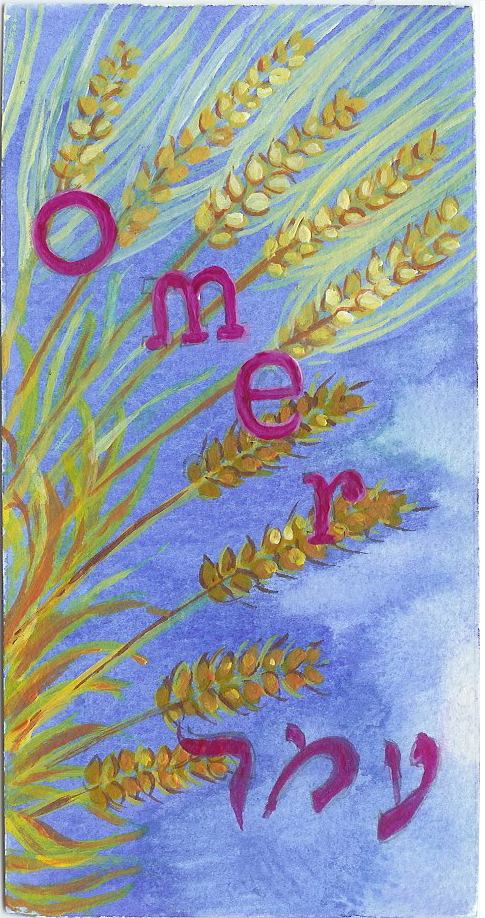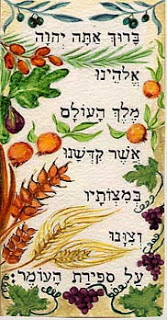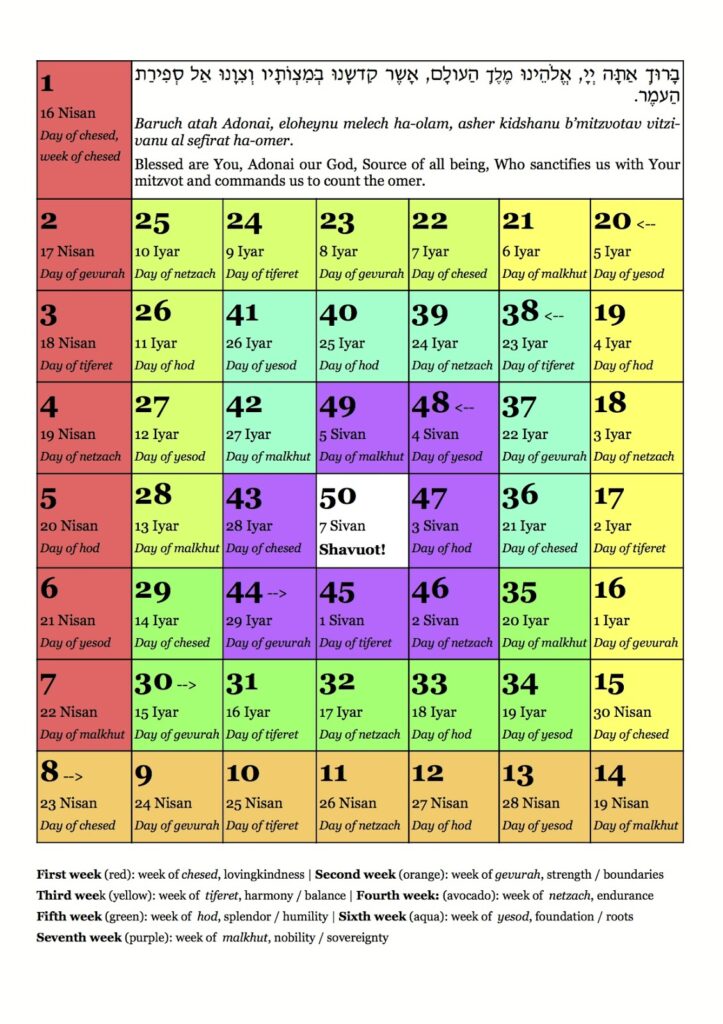Sefirat haOmer ~ A Counting from Pesach to Shavuot
Each year we have the opportunity to count the Omer ~ a counting of the span of time ~ seven weeks of seven days + One ~ from the second day of Passover (a holiday of redemption in the words of early rabbinic sages) to Shavuot (a holiday the early rabbis connected with revelation; in diaspora, we no longer brought our harvest to the Temple in Jerusalem, and rabbinic Judaism created new meaning for our holidays b’chutz/outside ha’Aretz/the Land).
In ancient times, Pesach and Shavuot were two of the three pilgrimage festivals (Sukkot is the third), when people brought the best of their harvest and bounty of the Land to the Sacred Source (at that time they connected with the Source at The Temple in Jerusalem). According to Torah (Vayikra/Leviticus 23:15-16), we are to count the omer (an ancient measure of grain) from Passover, the Festival of Freedom (Chag haMatzot/Holiday of Unleavened Bread in our liturgy) to Shavuot (Weeks), from the barley harvest to the wheat harvest and, ultimately, to the first offering on Shavuot itself of wheat from the new harvest, in the form of 12 loaves. In ancient times, barley from each week would be brought into the Temple and waved as an offering, really as a prayer that the harvest would come in successfully.

This mitzvah of sefirat/counting the Omer, was imbued with deeper spiritual meaning by Jewish kabbalists/mystics, from the middle ages to modern times, by connecting the qualities of the seven lower sefirot (the emanations of the Sacred in our world and in ourselves as sacred energy) with the seven weeks and seven days. These energies are:
First Week & First Day: Chesed – Love, Lovingkindness
Second Week & Second Day: Gevurah – Strength, Cultivating Power, Discipline, Healthy Boundaries
Third Week & Third Day: Tiferet – Beauty, Harmony, Balance
Fourth Week & Fourth Day: Netzach – Endurance, Eternity
Fifth Week & Fifth Day: Hod – Glory, Grace, Majesty
Sixth Week & Sixth Week: Yesod – Foundation
Seventh Week & Seventh Week: Malchut/Shekhinah – Sovereignty, Imminent Divinity, Grounding

Every night during the Omer we recite a blessing for doing and then say the count (number of days and weeks) which leads us from Passover to Shavuot. The Omer count is made starting the evening of each day – when the count happens at night the blessing is said and when the count happens during the daytime the blessing is not said. After the blessing the day is counted by absolute number and then by its number within each week, for example, “Today is the thirty-third day of the Omer, which is four weeks and five days.” (which would be Lag Ba’omer (lamed plus gimel, ל + ג = 33), by the way).
The challenge of counting the Omer is that it is one long mitzvah lasting 49 days. Thus, if you go one whole night and day without counting, the halakhah (Jewish law or structure for doing mitzvot, in this case) is to no longer say the blessing. “Making it all the way through seven weeks without missing a day is not easy for most of us! Hence, the proliferation of calendars, websites, and apps for counting the Omer,” says my friend, Rabbi David Seidenberg, creator of the app I use. You can find him and his app and many other valuable teachings at neohasid.org.
My favorite expansions on counting the Omer come from Rabbi Yael Levy, whom I have linked for reciting the blessing, above. Her website is a rich resource for counting and you can sign up for her daily emails with a meaningful practice paired with a beautiful photograph of the natural world. You can find Rabbi Yael Levy at A Way In (awayin.org). And this year, I have the privilege to be counting the omer in the container of eros and embodiment with Rav Kohenet Taya Ma and the Kohenet community (Kohenet.org). Although all of these materials can be acquired from their generous creators at no cost to you, their work is worthy of honor and I encourage you to also be generous when using these materials.
